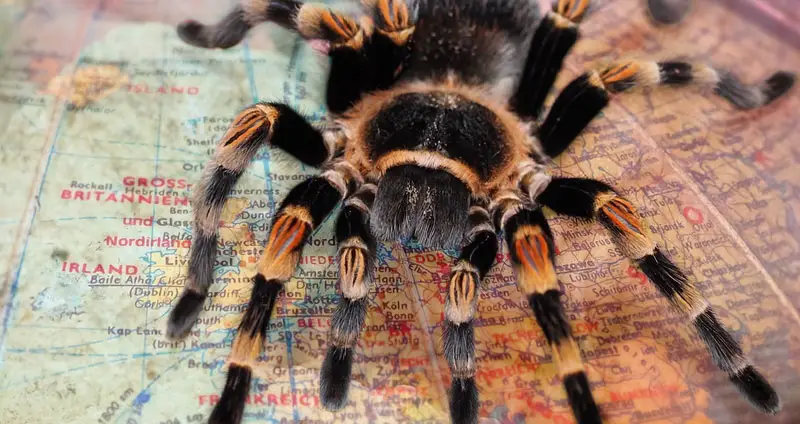Whether you’re an experienced tarantula owner or someone that’s just learning about these incredible creatures, there’s a good chance you’ve seen old world and new world tarantulas referenced. Many people think that old world tarantulas are simply species that roamed the earth long ago, while new world tarantulas only recently came into existence. While this is a good guess, that’s not true in the slightest.
So, what differentiates new world and old world tarantulas? Does one make for a better pet over another? What are some popular examples of both kinds? We aim to answer all that and more within this post.
Table of Contents
Old World Tarantulas
Despite their name, old world tarantulas have existed for about the same amount of time as new world tarantulas. However, they do have a few differences that make them unique to new worlds. It’s important that these differences are known, as old world tarantulas tend to not be favored by a lot of people for reasons that will be explained.
Old World Geography
Old world tarantulas are ultimately defined by their geographical location in the world. These tarantulas all come from the “old world”, which includes Asia, Africa, Australia, and Europe. Essentially, this is just the Eastern Hemisphere. This region is called the old world because it was inhabited before the discovery of the Americas in 1492.
This physical location itself doesn’t necessarily influence the physical traits of species from the old world. However, this entire region has bred tarantulas that have quite a similar nature, allowing this massively diverse area to simply be clumped into the “old world”.




Old World Tarantula Behavior
The behavior of old world tarantulas is what really makes them undesirable for a lot of beginner tarantula keepers. Virtually all tarantula species from this region are defined by their speed, aggressiveness, and quickness to bite when provoked. This unfavorable personality results in these tarantulas being essentially impossible to handle or interact with.
Old world tarantulas differ from new worlds in the sense that there are some new world tarantulas that exhibit old world characteristics. However, virtually all old world tarantula species behave the same with very few exceptions. If there is a more docile old world tarantula, it’s usually limited to that specific specimen.
Old World Tarantula Defense
One key characteristic of old world tarantulas is that they lack the urticating hairs that new world tarantulas have. These hairs are used as projectiles by threatened tarantulas and embed into a predator’s skin with tiny barbs. Without these hairs, old world tarantulas have to resort to quick movements and aggressive biting to fend off predators and subdue prey.
This has resulted in old world tarantulas having more painful bites and stronger venom than new world tarantulas. While not too much research has been done on specific differences in the venom, it’s been well-documented that old world tarantula bites can cause serious complications. Some common side-effects that can last from hours to days are localized pain and swelling, severe muscle cramping, exhaustion, fever, and labored breathing.
Old worlds also have some ‘bark’ to compliment their bite. Some species do something called stridulating which is the production of a loud hissing noise by rubbing the bristles on their legs together. This noise can be heard from up to 15 feet away and is quite terrifying to hear — especially if you aren’t expecting it. This is mostly done as a warning before a bite.
Common Old World Tarantulas
While essentially all old world tarantulas have a bad temper and are prone to biting, they can be quite diverse in their appearance. You’ll frequently find many old world tarantulas in experienced enthusiasts’ collections due to their incredible appearance and interesting personalities (when they’re alone).
Cobalt Blue – Cyriopagopus lividum
The cobalt blue is one of the most aggressive species of tarantula on earth. So aggressive, in fact, that even their young spiderlings attack their owners. Not only is their bite extremely painful, they’re known to bite twice in rapid succession. Fortunately, their venom is not considered dangerous to humans and is only effective when hunting prey.
This species lives deep underground in burrows that they either make or that they find and move themselves into. This makes for a tarantula that’s very interesting to observe and loves to be left alone — especially during the daytime when they aren’t active.
OBT – Pterinochilus murinus
This old world species got their name OBT (Orange Baboon Tarantula) because of its characteristic orange hair. It’s a very aggressive tarantula that’s quick to bite and moves at quite impressive speeds. They love to put on a show with their threat posture, revealing brilliant green and blue iridescent coloring under their feet.
Due to their short temper and very painful bite (that’s not harmful to humans), it’s not recommended that inexperienced tarantula keepers own this species. If you do own one, though, its tunnels are impressive and personality certainly isn’t boring.
King Baboon – Pelinobius muticus
This old world tarantula is a very slow-growing species that’s usually orange or rust-brown in color. It has very strong back legs that are used for digging burrows that the tarantula likes to stay hidden in.
This species is very popular among tarantula collectors, but it’s very defensive and not recommended for inexperienced keepers. Their bite also contains strong venom that isn’t dangerous to humans but can cause a good deal of pain.
While tarantulas of this species of tend to be aggressive, some are actually quite gentle.
New World Tarantulas
New world tarantulas are some of the more commonly-kept tarantula species by both experienced and novice owners. They’re similar in a few ways to old world tarantulas, but there are a few key differences. If you’re looking into getting your first tarantula, you’ll most likely want to look for a new world.
New World Geography
New world tarantulas come from just that — the “new world”. This area the Western Hemisphere, including North, Central, and South America. This area is called the new world since the Americas were discovered after Europe, Asia, Africa, and Australia.
North, South, and Central America all have very different climates and geological characteristics, so there is quite a diverse array of new world tarantulas. However, like in the old world, there are some overarching traits that apply to most tarantulas in this region.




New World Tarantula Behavior
Compared to old worlds, new world tarantulas are several degrees of magnitude better for a good portion of owners. Most new world tarantulas are quite slow-moving, a lot less irritable, and rarely resort to biting their attackers. It’s for this reason that these tarantulas are recommended for new tarantula owners or owners that would prefer to handle their specimens.
However, it’s not all cut-and-dry. The popular members of the Avicularia genus such as the Pink Toe tarantula, Ecuadorian woolly, Venezuluelan redstripe, and Ecuadorian purple are defined by their very calm nature. However, the remaining five genera do contain quite a few specimens that are high-strung, fast-moving, and defensive. They may not exhibit these traits to the extent of old world tarantulas, but they show the traits nonetheless.
Therefore, it’s necessary that you thoroughly research the temperament of the exact new world tarantula that you’re interested in before purchasing it. Tarantulas such as the Trinidad chevron and essentially the entire Ephebopus genus are new worlds but are very fast and quick to bite — much like old worlds.
New World Tarantula Defense
Most new world tarantulas have a very different way of defending themselves from old worlds. Of course, there are exceptions to this, but most use their urticating hairs as their primary method of self defense.
Urticating hairs are barbed hairs that cover both the posterior and dorsal surface of the abdomen of Tarantulas. When threatened, new world tarantulas will kick the urticating hairs off of their abdomens in the direction of their attackers with surprising accuracy. These hairs embed themselves into an animal’s skin or eyes and cause serious irritation.
It has been suggested that these urticating hairs don’t just offer a simple physical agitation, but they also have a chemical influence. Large amounts of these small hairs can get into the mucous membranes of animals and result in edema which is the increase of interstitial fluid in an organ.
While some new world tarantulas can do resort to biting (but hurt much less than old world tarantulas), others have different means of defense. For example, the Pink Toe tarantula will spray feces at their attacker instead of urticating hairs. This is a harmless attack for humans, but it’s definitely not the most enjoyable thing to deal with.
Common New World Tarantulas
There is an extremely wide variety of new world tarantulas with a plethora of different quirks and characteristics. Below are three of the most commonly-kept new world tarantulas that are commonly kept by both experienced and beginner tarantula keepers alike.
Pink Toe – Avicularia avicularia
Pink Toe tarantulas are some of the most commonly-kept tarantulas, and it’s quiet clear why that is. This species is the definition of a new world tarantula. That is, it’s not very jumpy, only moderately quick, not quick to bite, and easy to handle. All of these characteristics make it a great tarantula for first-time tarantula owners.
They have mostly black bodies that feature a healthy amount of hair and are pinkish-orange around the bottoms of their feet. Pink Toes spend most of their time hanging around the top of their enclosure due to the fact that they’re an arboreal species.
Goliath Birdeater – Theraphosa blondi
This is a species that’s fairly well-known even among people that don’t know much about tarantulas. Getting its name from the fact that it’s been observed eating birds in the wild, theraphosa blondi is a massive species that can have a 12 inch leg span and a body the size of a tennis ball.
Despite its massive size, this is a new world tarantula that people love to own and handle. It can move quite quickly despite its size, but it’s still a relatively relaxed and docile tarantula. The urticating hairs on this species are quite severe, though, and have been compared to shards of fiberglass.
Curly Hair – Brachypelma albopilosum
The extremely docile nature of these tarantulas makes them an optimal pet for a lot of people, but others find them quite boring. While they will move about their cage and rearrange some accessories within it, they don’t do much else besides that.
Brachypelma albopilosum are easily spooked and don’t enjoy being handled for extended periods of time. They also have urticating hairs that aren’t very severe. Because of this, this tarantula species is more for owners that prefer to take an “observe don’t touch” approach with their animals. Overall, they are still fascinating specimens.
Old World Vs. New World Tarantula Breakdown
As you can see, there are a few very prominent differences between these two types of tarantulas. Knowing these key differences is essential if you’re looking to add a new tarantula to your collection. Whether your tarantula is a new world or old world determines how they should be treated when being cared for.
Old World Tarantulas
- From the Eastern Hemisphere, specifically Asia, Africa, Australia, and Europe
- Very quick, aggressive, and don’t like to be handled
- Uses its bite as its main form of defense and attack
- Virtually all old world tarantulas have these traits
New World Tarantulas
- From the Western Hemisphere, specifically North, Central, and South America
- More docile, friendly, slower, and less easily-provoked
- Most species rely on their urticating hairs for defense
- A good portion of new world tarantulas have these traits

